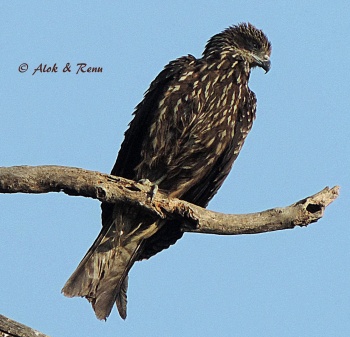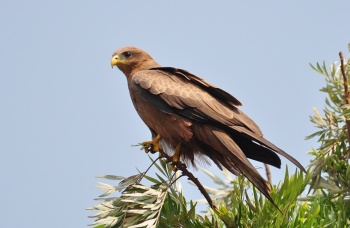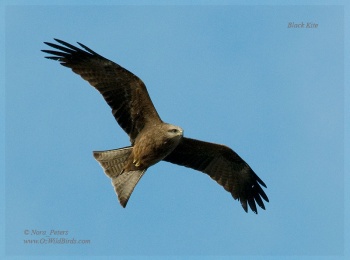Aloktewari (talk | contribs) (Image of immature added.) |
Aloktewari (talk | contribs) (Legend of image four improved) |
||
| Line 21: | Line 21: | ||
Does not have the deeply forked tail of a [[Red Kite]], but can look almost as rufous. Tail of Black Kite is also shorter; on the sitting bird, primaries reach the end of the tail on Black Kite but reach the base of the fork in the tail on Red Kite. Black Kite has less contrast between dark primary tips and white primary bases. Black Kite shows six free primary tips in the extended wing, Red Kite shows five. | Does not have the deeply forked tail of a [[Red Kite]], but can look almost as rufous. Tail of Black Kite is also shorter; on the sitting bird, primaries reach the end of the tail on Black Kite but reach the base of the fork in the tail on Red Kite. Black Kite has less contrast between dark primary tips and white primary bases. Black Kite shows six free primary tips in the extended wing, Red Kite shows five. | ||
==Distribution== | ==Distribution== | ||
| − | [[Image:Black-Kite-ssa-2-8-08.jpg|thumb|350px|right|Photo by {{user|Nora|Nora}}<br /> | + | [[Image:Black-Kite-ssa-2-8-08.jpg|thumb|350px|right|Photo by {{user|Nora|Nora}}<br />Serendip Sanctuary, Lara, Melbourne, [[Victoria]], [[Australia]], August, 2008]] |
[[Eurasia]], [[Africa]] and [[Australia]]. Breeds across mainland [[Europe]] from [[Iberia]] east to the Urals. Common and widespread in [[Spain]] but patchy in [[France]] and central Europe, [[Italy]] and [[Greece]]. Absent from the [[British Isles]] and most of [[Scandinavia]] but a small number breed in southern coastal [[Finland]] and a rare breeder in [[Sweden]]. Has bred regularly in [[Belgium]] since the 1970s and first breeding for the [[Netherlands]] took place in 1996. Breeding in Finland in 2002 was the first for decades. | [[Eurasia]], [[Africa]] and [[Australia]]. Breeds across mainland [[Europe]] from [[Iberia]] east to the Urals. Common and widespread in [[Spain]] but patchy in [[France]] and central Europe, [[Italy]] and [[Greece]]. Absent from the [[British Isles]] and most of [[Scandinavia]] but a small number breed in southern coastal [[Finland]] and a rare breeder in [[Sweden]]. Has bred regularly in [[Belgium]] since the 1970s and first breeding for the [[Netherlands]] took place in 1996. Breeding in Finland in 2002 was the first for decades. | ||
Revision as of 04:08, 14 September 2016

- Milvus migrans
Includes Yellow-billed Kite; Black-eared Kite
Identification
Length 44–66 cm (17¼-26 in), wingspan 135-155 cm, weight 560-940 g
Male
Dull pale brown crown, back of head and nape, with dark brown streaks
- Dull brown chin, throat and breast with darker stripes
- Rufous underwings
- Brown-grey tail barred darker
- Black bill with yellow at base of lower mandible
- Yellow cere
- Pale grey-yellow iris surrounded by a black line
- Yellow legs and toes with black claws
- In flight shows 6 free primaries
Female: is marginally larger, darker and redder
Young: dark iris, more mottled plumage, each feather tipped with a greyish white or ferruginous patch. The bands on the tail are less distinct.
Similar Species
Does not have the deeply forked tail of a Red Kite, but can look almost as rufous. Tail of Black Kite is also shorter; on the sitting bird, primaries reach the end of the tail on Black Kite but reach the base of the fork in the tail on Red Kite. Black Kite has less contrast between dark primary tips and white primary bases. Black Kite shows six free primary tips in the extended wing, Red Kite shows five.
Distribution
Eurasia, Africa and Australia. Breeds across mainland Europe from Iberia east to the Urals. Common and widespread in Spain but patchy in France and central Europe, Italy and Greece. Absent from the British Isles and most of Scandinavia but a small number breed in southern coastal Finland and a rare breeder in Sweden. Has bred regularly in Belgium since the 1970s and first breeding for the Netherlands took place in 1996. Breeding in Finland in 2002 was the first for decades.
In Asia breeds across most of Turkey, the Middle East and the Arabian Peninsula and east across temperate and tropical Asia to the Pacific coast of Russia, Japan and China. To the south breeds throughout India and Sri Lanka and South-East Asia to southern Thailand. Also breeds in Sulawesi, eastern New Guinea and the Bismarck Archipelago. Widespread in much of Australia, particularly the north and centre and absent only from the southern coastal regions.
In Africa breeds across the North-West, in Egypt and throughout sub-Saharan Africa from Senegal to Somalia and south to the Cape. Also breeds in the Cape Verde Islands.
Northern populations are migratory and winter to the south. Most European birds winter in sub-Saharan Africa although a few may remain in southern Europe in winter and occasionally wintering birds occur north to southern Scandinavia. Dispersal of young birds can start in late June but migration begins in late July-August, and most have left breeding areas by September. Migrants concentrate at narrow sea-crossings during August-October, the peak period being mid-August to mid-September. Numbers are highest at Gibraltar, but also occurs in thousands at the Bosphorus and at Borçka in Turkey. Smaller numbers occur as migrants through Italy.
The return movement in spring occurs February-May with a peak in March-April and the same routes are used. Regularly seen north of main breeding range and there has been some expansion of range in Europe in recent decades. Now annual in Britain ( c. 313 records), mostly in east and south-east England in the period mid April-early June with occasional autumn records. Breeding attempts may occur in Britain in the future.
Vagrants also recorded in the Channel Islands and Iceland. In Australia vagrants recorded on the south coast and Tasmania.
Taxonomy
About seven races are recognised:[1]
The nominate subspecies M. m. migrans occurs over most of the Western Palearctic with M. m. lineatus (Black-eared Kite) found in central and eastern Asia, M. m. formosanus in Taiwan and Hainan, M. m. govinda from in India to southeast Asia, and M. m. affinis from Indonesia to Australia.
M. m. aegyptius in Egypt and Sinai, Somalia and Arabia, and M. m. parasitus in sub-Saharan Africa and Madagascar, have a yellow bill as adults, and slightly plainer brown plumage. They also genetically distinct, more closely related to Red Kite than to nominate Black Kite, and are now widely recognised by many authors as a separate species, the Yellow-billed Kite Milvus aegyptius[2][3].
M. m. tenebrosus on the Cape Verde Islands is generally considered invalid[4]
Habitat
Often close to water, near rivers, lakes and seacoasts and in the south of range closely associated with man. There it is frequent around towns and villages, refuse-tips and slaughterhouses; also patrols roads for roadkill animals. Breeds in tall trees in open or sparsely wooded country.
Behaviour
Usually gregarious, especially on migration.
Diet
The diet includes live prey as well as fish, household refuse and carrion.
Breeding
They nest in forest trees, often close to other kites.
Vocalisation
<flashmp3>Milvus migrans (song).mp3</flashmp3>
Listen in an external program
References
- Clements, J. F., T. S. Schulenberg, M. J. Iliff, D. Roberson, T. A. Fredericks, B. L. Sullivan, and C. L. Wood. 2015. The eBird/Clements checklist of birds of the world: v2015, with updates to August 2015. Downloaded from http://www.birds.cornell.edu/clementschecklist/download/
- Gill, F and D Donsker (Eds). 2015. IOC World Bird Names (version 5.1). Available at http://www.worldbirdnames.org/.
- Scheider, J., Wink, M., Stubbe, M., Hille, S., & Wiltschko, W. (2004). Phylogeographic relationships of the Black Kite Milvus migrans. Pages 467–472 in Chancellor, R. D., & Meyburg, B-U. [eds.], Raptors worldwide: proceedings of the VI World Conference on Birds of Prey and Owls. World Working Goup on Birds of Prey, Berlin, Germany.
- Lepage D. 2007. Avibase. Search for "Milvus aegyptius" downloaded 17 September 2007.
- BirdCheck.co.uk
- Birdforum thread discussing id of Red vs Black Kite
- Birdforum thread discussing the subspecies of black kite including link to id hints
Recommended Citation
- BirdForum Opus contributors. (2024) Black Kite. In: BirdForum, the forum for wild birds and birding. Retrieved 24 April 2024 from https://www.birdforum.net/opus/Black_Kite
External Links






